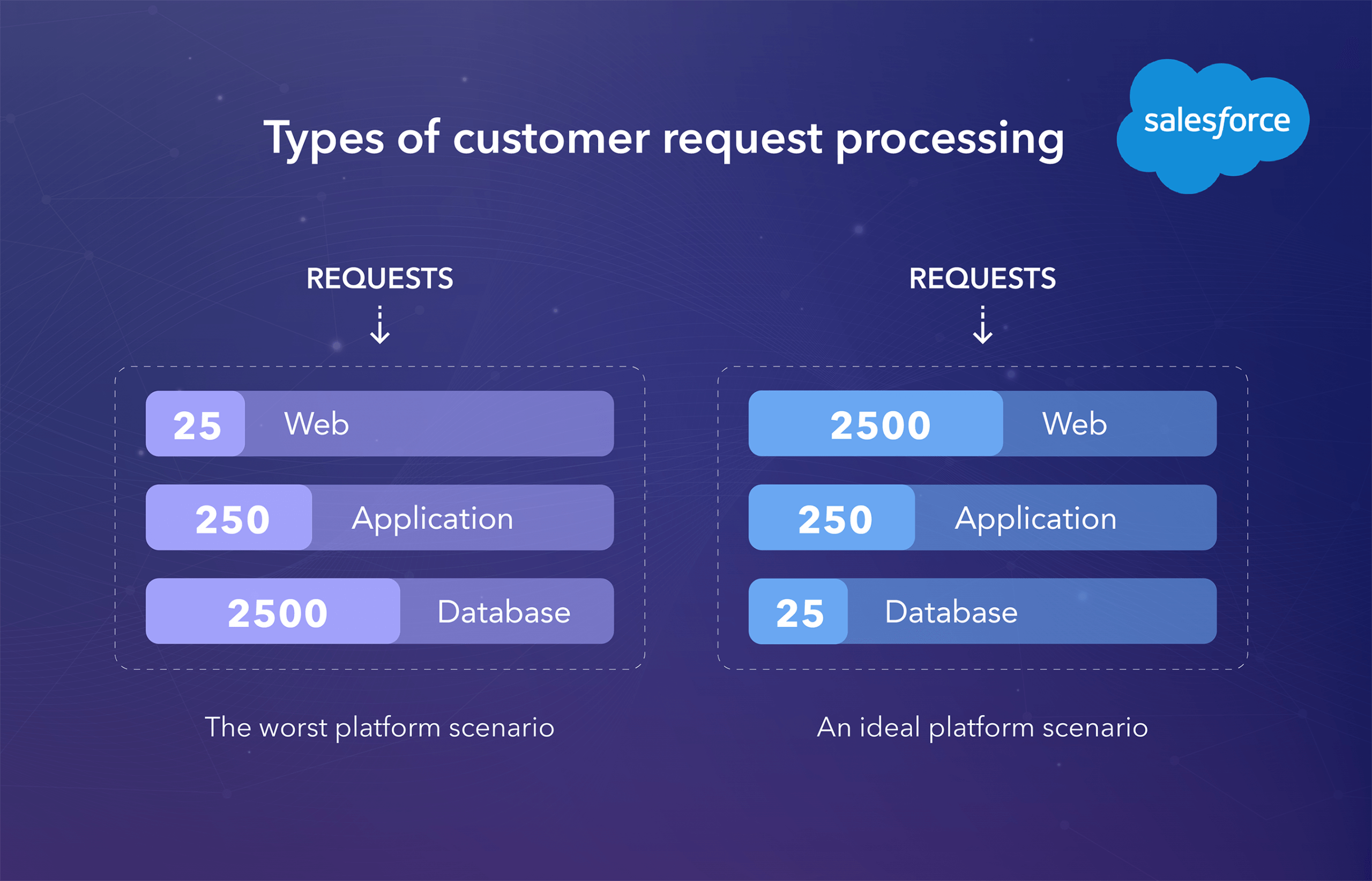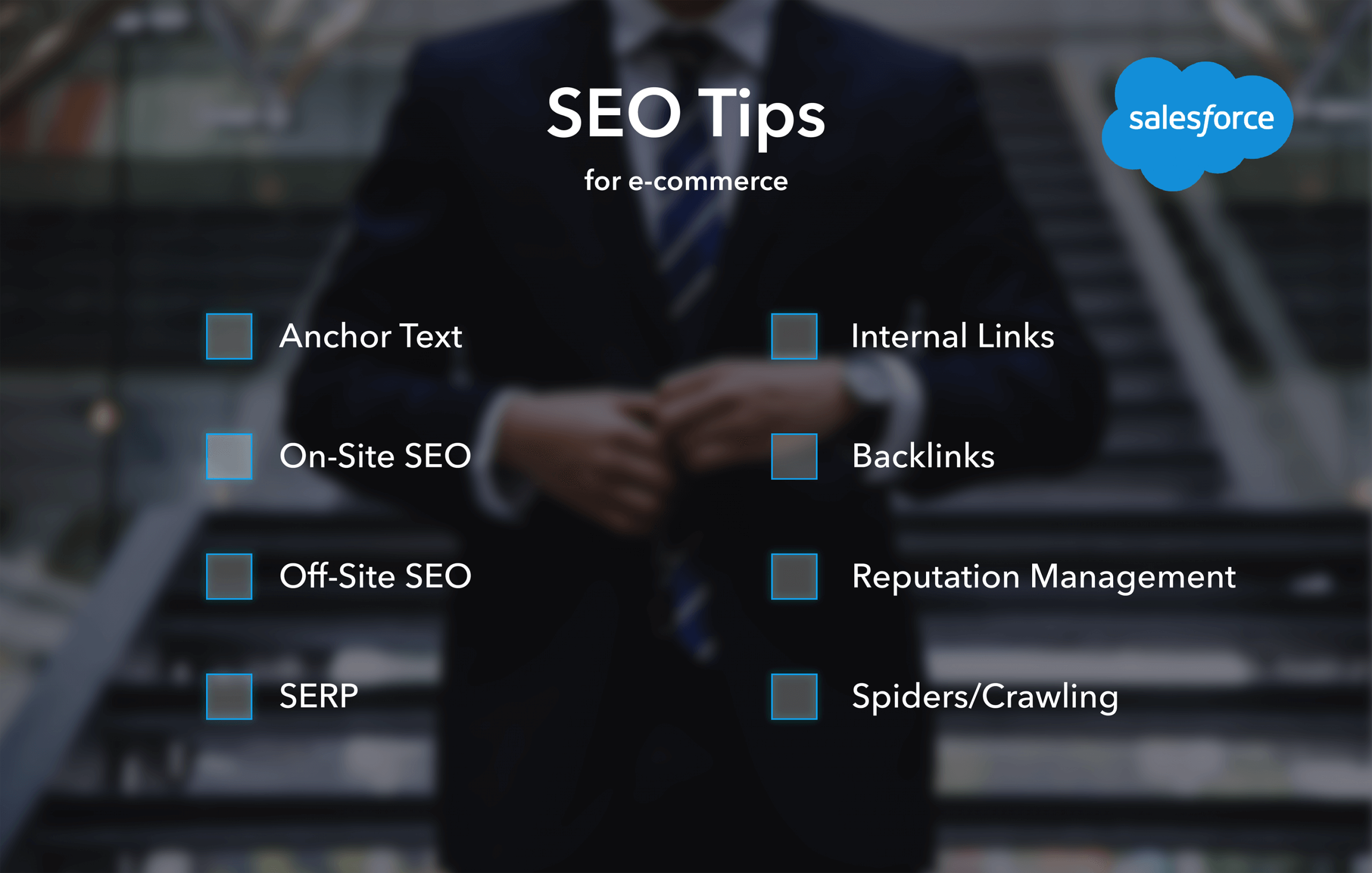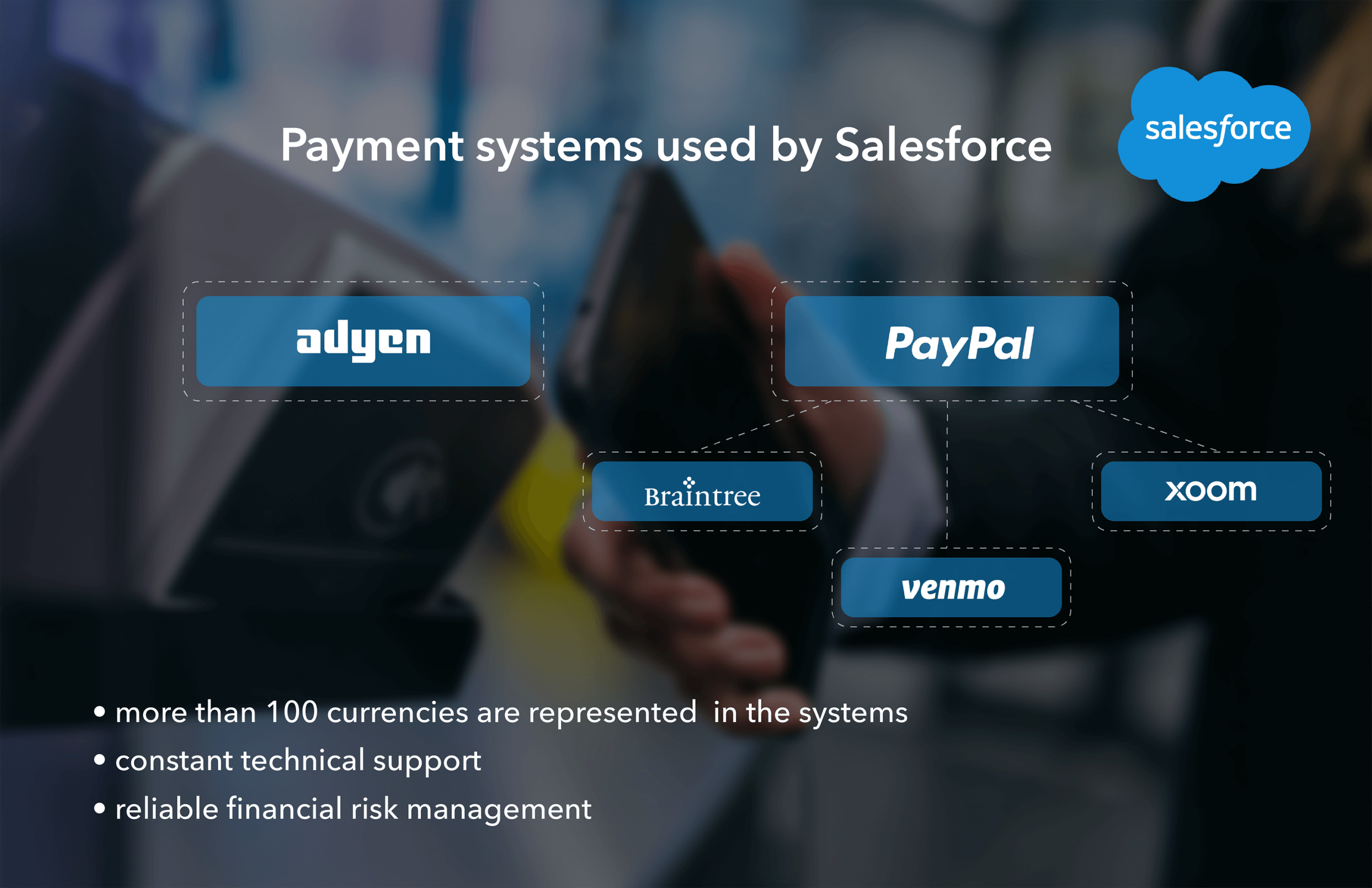E-commerce has deeply entered the market and people’s minds: without an online presence, a retailer can’t have a profitable business today. If you are not on the web, you don’t exist as they say. Yet, e-commerce is all about customer comfort while shopping that is why the best e-commerce platforms fight for the most intuitive design, the highest responsiveness, and the most immaculate operational flow of their online stores. Salesforce, with its Salesforce Commerce Cloud, is an undisputed leader in this field.
What Does a Perfect E-Commerce Store Look Like?
For a customer to make a purchase, an online store must be convenient, understandable, and enjoyable. The owner of the e-commerce store must quickly and efficiently process requests. The integration with the CRM system should also be accessible.
A distinctive feature of the high-quality e-commerce platform, besides its intuitive UI/UX and responsiveness, is the possibility of integration into the cloud. Business representatives do not spend capital on the difficulties associated with installing, updating, and maintaining the operability of equipment and software running on it.
Today we will look at various components of Salesforce Commerce Cloud to understand how to build a perfect online shop on this platform. We will also discuss the typical users’ mistakes, difficulties, and benefits of Salesforce Commerce Cloud.
Typical Mistakes In Salesforce Commerce Cloud Development
1. Neglecting Response Time
One of the most important components of the efficient e-commerce platform functionality is response time. The client hates to wait even if he is buying a pair of sneakers. Each millisecond is tragic for him. Response time is the time interval that elapses between the sending of a client’s request and the response to this request. In case the response time of an e-commerce store exceeds a second! There is a high possibility that the client will switch to another website.
This time may increase in cases when developers do not pay due attention to such aspects of development as:
- Correct caching of data on pages;
- CSS and JavaScript block the display of the main content.
This affects a number of significant indicators, which will directly affect site traffic, and, therefore, the size of profits or even business losses. Let us analyze the main indicators that are affected by the mentioned above mistakes:
- Quality ranking website in search engines. The speed of loading the pages of a site is one of the important parameters in its optimization. Poor behavioral metrics can lead to sagging site positions in SERPs (Search Engine Results Pages).
- Slow loading makes search engine robots unusable. They will not be able to clearly index its content, so it will fall in the SERP.
- It is also no secret that in July 2018, Google began to use the Google Speed Update algorithm, which is designed to reduce the position of pages with low download speed for mobile issuance.
How Does Salesforce Solve This Problem?
In addition to the incredible capabilities of the Salesforce platform itself, the reliable performance and efficiency of cases running on the Salesforce Commerce Cloud platform depend not only on the capabilities of the platform itself but also on the experience of programmers who adapt the systems to the customer needs.
Capabilities of Salesforce in tandem with experienced specialists will help to avoid the problems above. We will examine in more detail how exactly this happens:
1. Сache.
A cache is a dedicated memory for storing prepared data, which minimizes the need for unnecessary calls to the database, designed to speed up access to data. When developing large sales platforms, it is the cache that is the life-saving component in increasing the response speed. There are three aspects to working with the cache that you need to know.
- It’s vital to conduct a powerful analysis of your data and understand which data is worth caching for users and which is not worth it. The cached resource and it is limited, will not be spent on the data the user needs. Thus, it will be just useless.
- Salesforce Commerce Cloud makes it possible not only to select specific data that will be added to the cache but also to choose which places on a specific page will be cached, which significantly increases the speed of launching and making changes to the project. Also, do not forget that certain areas on the page, such as the basket, should never be cached.
- And the last aspect, but not in significance, is that the lion’s share (the more, the better) of the queries should reach only the web level. The remaining small amount is already up to the level of application, and only a tiny fraction can reach the database level. If working with the cache is not built correctly, then all events will develop in reverse order.
Initially, this will lead to an exponential increase in application server traffic with increased traffic. And with massive access to database queries, the whole platform will slow down.

2. Powerful server system.
One of the obvious benefits of working with Salesforce Commerce Cloud is its well-thought-out server location system. Big brands choose this e-commerce platform because they are sure that there are servers located in all the parts of the planet so their clients won’t have to wait for a long response. Today servers are located in the following spots:
- Chicago, Illinois, United States (USA)
- Dallas, Texas, United States (USA)
- Frankfurt, Germany (GER)
- Kobe, Japan (JPN)
- London, United Kingdom (UK): London, UK (North) & London, UK (West)
- Paris, France (FRA)
- Phoenix, Arizona, United States (USA)
- Tokyo, Japan (JPN)
- Washington, DC, United States (USA)
In addition, there are several data centres served by the Amazon Web Services (AWS) cloud infrastructure in Canada and Australia. It means that anywhere in the world the response of a site to a client’s request will be equally fast.
2. Ignoring SEO for E-commerce
Ignoring SEO (search engine optimization) for e-commerce stores is one of the most serious mistakes clients make because of unawareness of its importance. SEO is the tool that alleviates clients’ search for the goods on the website and an adequate range of products.
Creating an SEO-powered e-commerce store is a must in the modern world. Luckily, the rules of SEO optimization for an online store are not very different from any other website. Classic tips for SEO for e-commerce are pretty much the same as for any website.
Here are the elements any e-commerce store developer should take into account when launching a brand-new store:
- Anchor Text.
- On-Site SEO.
- Off-Site SEO.
- SERP.
- Internal Links.
- Backlinks.
- Reputation Management.
- Spiders/Crawling.

Paying attention to these key elements of SEO will lead to the high position of a website in Google search as well.
3. Use of Unreliable Systems: Possibilities of Integration with Payment Systems
An important benefit of Salesforce Commerce Cloud is the possibility of secure and fast financial transactions. Luckily, Salesforce Commerce Cloud can be integrated with the most popular among them: PayPal and Adyen.

PayPal
One of the best features of integration with PayPal is openness and the ability to work with it anywhere in the world. Paypal developers have ensured that more than 100 currencies are represented in the system.
We also want to pay attention to the partner companies that PayPal included. These are Braintree, Venmo, and Xoom. Before the merger with PayPal, these companies have already established themselves as powerful players in the market of electronic financial services. With their help, PayPal has reached a global level of customer service.
Adyen
The service provides intelligent integration of payment systems in any type of online store. Working conditions with this system also include constant technical support. The payment system acts as a payment gateway, and a payment service provider, and offers financial risk management, as well as acquiring local services.
Integration with Logistics and Tracking Systems: UPS
Adapting your website for local currencies and payment methods, as well as a collection of duties and taxes at checkout, makes it difficult to sell to consumers in other countries. It’s not enough for the client to simply choose a product, he also wants to be able to choose its speed, price, location and other properties. At the same time, the level of reliability of the shipment should not change.
Also, one must not forget to think over the system for tracking the parcel not only by managers but also by the client himself. This feature is easy to implement on your website or application. This opportunity significantly reduces the workload of call center employees.
In addition, the trend toward a reduction in courier deliveries has begun to strengthen logistics. It would seem that it can be more convenient than the person who will bring the package to your hands. But experience shows that this type of delivery makes people dependent on delivery time. There are more and more places where the client can pick up the package. Often these places become fully automated, such as a post office for small parcels in a nearby supermarket.
By implementing a convenient and reliable delivery system UPS in your store, you significantly increase the level of customer confidence.
NARVAR
In order to build a system of stable profit growth, you need to set a goal not just to sell the goods but to build the relationship of your brand with the client. That is, interaction with the client after the purchase. The pleasant emotional, not intrusive experience causes customer loyalty. How can I do that? With convenient order tracking, proactive communications, and the smooth and easy return of goods. The customer is also favorably affected by discounts on repeat orders. Narvar uses Machine Learning technology to streamline the buying process for customers and analytics and strategies for retailers.
Product Ranging Based on GeoLocation
The advantage of the Salesforce Commerce Cloud is the ability to define goods for the demonstration depending on geolocation and other entered parameters. This property directly affects profit growth as a result of the demonstration of the necessary and relevant goods for a certain community of people. For example, well-insulated coats with special frost-resistant material will be shown only to users residing in northern latitudes, where this product will be needed. On the same page in Spain, for example, we will not display this model specifically. There will be jackets and coats.
Conclusion
Salesforce makes and saves companies money. Saving funds occurs by cutting off unnecessary positions – buying servers, maintaining the staff of system administrators, and paying for the downtime of each specialist from the entire product creation cycle. Technical support for the application is included in the payment. Also, the modernization and updating of the application are quick and transparent for customers.
With the help of Salesforce Commerce Cloud, you can create an e-commerce platform that will not only bring money thanks to a convenient and working system but also knowledge about the desires and behavior of your customers, which will also be converted into money in the future. Our team of specialists will deploy your store based on the Salesforce Commerce Cloud platform, taking into account all your wishes and market requirements.




